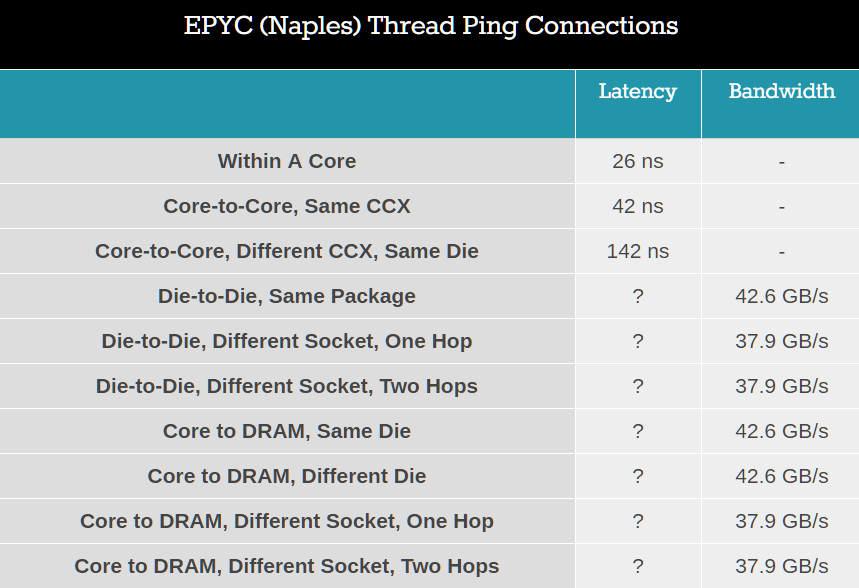Intel "mesh" vs intel "Ring"
- Thread starter csbin
- Start date
You are using an out of date browser. It may not display this or other websites correctly.
You should upgrade or use an alternative browser.
You should upgrade or use an alternative browser.
Edrick
Golden Member
- Feb 18, 2010
- 1,939
- 230
- 106
Sacrifice latency for more bandwidth. Probably more important in the server level tasks these chips were designed for.
Yeaa. We have seen that before.Sacrifice latency for more bandwidth. Probably more important in the server level tasks these chips were designed for.
You're forgetting something that a ring bus necessitates, and that is a linear latency increase with each added node. If you tried to scale the ring up to those counts, the ring latency would be greater, so in fact no, they haven't "sacrificed latency for more bandwidth". It's actually reduced latency for what a ring would have.
NTMBK
Lifer
- Nov 14, 2011
- 10,232
- 5,013
- 136
You're looking at too low a core count. The ring bus was killing them in the 24-core die last time, they had to use two rings tied together with buffered queues:

The mesh is designed to scale much better to those core counts. The mesh latency should scale as sqrt(n), instead of linearly.
I'm curious to see what the next Xeon D uses. My guess is that it will stick with the "consumer" cores with no AVX512 and use a ringbus.

The mesh is designed to scale much better to those core counts. The mesh latency should scale as sqrt(n), instead of linearly.
I'm curious to see what the next Xeon D uses. My guess is that it will stick with the "consumer" cores with no AVX512 and use a ringbus.
moinmoin
Diamond Member
- Jun 1, 2017
- 4,944
- 7,656
- 136
The change from ring to mesh is absolutely a necessity as the amount of cores increases. What's concerning is the huge increase in die size that comes along with it. Or is that down to AVX512?
moinmoin
Diamond Member
- Jun 1, 2017
- 4,944
- 7,656
- 136
Was thinking of this post:What is said die size?
https://forums.anandtech.com/thread...-19-9-00-am-et.2428363/page-496#post-38943496
BTW, the die size has also grown quite a bit.
Broadwell-E 10C die is like 240; Skylake-X 10C die is around 325.
By my totally reliable estimations by looking at the die pict, the core size (inc L3) is about 17 mm2. Kaby Lake is by the same estimation 12.2 mm2.
It has very significantly grown to 17.0 mm2 indeed.

lolfail9001
Golden Member
- Sep 9, 2016
- 1,056
- 353
- 96
Down to AVX512 probably, the register file alone must have increased fourfold or something.Or is that down to AVX512?
Down to AVX512 probably, the register file alone must have increased fourfold or something.
According to the Anandtech review, the register file takes up more space than an entire Atom core...
nathanddrews
Graphics Cards, CPU Moderator
Hopefully adds some context for the clowns yapping on about Zen, IF and latency.
The clowns were the ones ignoring or dismissing the issue.
wildhorse2k
Member
- May 12, 2017
- 180
- 83
- 71
Actually the Ryzen latencies make more sense in the long run. You want very low latencies for low thread count applications and applications needing more threads need to optimize. Giving bad latency to all cores is a bad idea.
The problem with Ryzen is that perhaps the cross CCX latencies are way too high. We will see how it goes for Threadripper, but cross die latencies will probably be even higher than 140ns.
The problem with Ryzen is that perhaps the cross CCX latencies are way too high. We will see how it goes for Threadripper, but cross die latencies will probably be even higher than 140ns.
You purchase low latency ram - problem solved.Actually the Ryzen latencies make more sense in the long run. You want very low latencies for low thread count applications and applications needing more threads need to optimize. Giving bad latency to all cores is a bad idea.
The problem with Ryzen is that perhaps the cross CCX latencies are way too high. We will see how it goes for Threadripper, but cross die latencies will probably be even higher than 140ns.
moinmoin
Diamond Member
- Jun 1, 2017
- 4,944
- 7,656
- 136
On that matter for Intel, we know that the ring bus didn't improve as much with higher speed/lower latency ram. Do we already have numbers on how the mesh behaves with higher speed/lower latency ram?You purchase low latency ram - problem solved.
wildhorse2k
Member
- May 12, 2017
- 180
- 83
- 71
On that matter for Intel, we know that the ring bus didn't improve much with higher speed/lower latency ram. Do we already have numbers on how the mesh behaves with higher speed/lower latency ram?
PcPer review shows it. DDR4 2400 you get about 105ns latency. DDR4 2800/uncore 2800 (stock uncore is 2.4Ghz) you get about 95ns. I saw comment from der8auer on youtube that you can run uncore up to 3-3.2Ghz. According to him the highest DDR4 frequency is 3600-4000. With that you could get down to perhaps 90ns-85ns (absolute best case). But TDP will very likely increase.
It would be unfair to only point out the negatives. According to http://www.tomshardware.com/reviews/intel-core-i9-7900x-skylake-x,5092-3.html cache has superior multi thread throughput.
On Ryzen by using DDR4 3200 the inter CCX latency reportedly drops to about 105ns which isn't too bad (not shown in review).
lolfail9001
Golden Member
- Sep 9, 2016
- 1,056
- 353
- 96
Uncore is not really tied to memory clock on Intel CPUs.On that matter for Intel, we know that the ring bus didn't improve as much with higher speed/lower latency ram. Do we already have numbers on how the mesh behaves with higher speed/lower latency ram?
Atari2600
Golden Member
- Nov 22, 2016
- 1,409
- 1,655
- 136
The clowns were the ones ignoring or dismissing the issue.
You'd think that now the two main x86 design houses have decided to trade-off latency for improved bandwidth or scaleability then folks would accept that maybe latency isn't as important as they think.
Obviously not.
Well - I guess we'll know when benchmarks come out of SKL-X on games (since a high proportion of clowns use these exclusively as reflective of "performance") as to how important latency is when the software, compiler and scheduler are optimised to keep threads on the same cores where possible and prefetch data where possible.
Oh actually no. What will happen is the same clowns will pick out inappropriate results from inappropriate code and use it to justify their pre-conceived idiocy.
itsmydamnation
Platinum Member
- Feb 6, 2011
- 2,764
- 3,131
- 136
I think it'll be about 160ns to go inter die on there test, the big bit of the latency number will be cache coherency, which shouldnt grow compared to a single zepplin.Actually the Ryzen latencies make more sense in the long run. You want very low latencies for low thread count applications and applications needing more threads need to optimize. Giving bad latency to all cores is a bad idea.
The problem with Ryzen is that perhaps the cross CCX latencies are way too high. We will see how it goes for Threadripper, but cross die latencies will probably be even higher than 140ns.
ub4ty
Senior member
- Jun 21, 2017
- 749
- 898
- 96
I think it'll be about 160ns to go inter die on there test, the big bit of the latency number will be cache coherency, which shouldnt grow compared to a single zepplin.

itsmydamnation
Platinum Member
- Feb 6, 2011
- 2,764
- 3,131
- 136
There is a paper that i have a copy of ( i dont know where i got it) that has bulldozers NUMA latencies. Im basing my guesses of that. For BD going intra package was 41ns. Going one socket hop was only an extra 7ns on that. But its interconnects where much slower and its internal system topology is significantly worse.
But even in Ryzen the cache directory when going inter CCX will be checked to see if the dest memory address in is the other CCX or the fetch is to main memory, so that time shouldn't grow much as its just the physical transmit latency to add when querying a remote cache directory/memory controller + then the extra physical latency for the returned data/result.
Thus my guess of an extra 20ns.
beginner99
Diamond Member
- Jun 2, 2009
- 5,210
- 1,580
- 136
Well - I guess we'll know when benchmarks come out of SKL-X on games (since a high proportion of clowns use these exclusively as reflective of "performance") as to how important latency is when the software, compiler and scheduler are optimised to keep threads on the same cores where possible and prefetch data where possible.
Oh actually no. What will happen is the same clowns will pick out inappropriate results from inappropriate code and use it to justify their pre-conceived idiocy.
We will see how latency and mesh vs ringbus affects gaming when Skylake-X and coffelake gaming reviews are here. The 6-core coffelake can then be directly compared to 7800kand my bet is coffelake will be the clear winner (even at same clocks).
TRENDING THREADS
-
Discussion Intel current and future Lakes & Rapids thread
- Started by TheF34RChannel
- Replies: 23K
-
Discussion Zen 5 Speculation (EPYC Turin and Strix Point/Granite Ridge - Ryzen 9000)
- Started by DisEnchantment
- Replies: 9K
-
-
Discussion Intel Meteor, Arrow, Lunar & Panther Lakes Discussion Threads
- Started by Tigerick
- Replies: 7K
-

AnandTech is part of Future plc, an international media group and leading digital publisher. Visit our corporate site.
© Future Publishing Limited Quay House, The Ambury, Bath BA1 1UA. All rights reserved. England and Wales company registration number 2008885.






